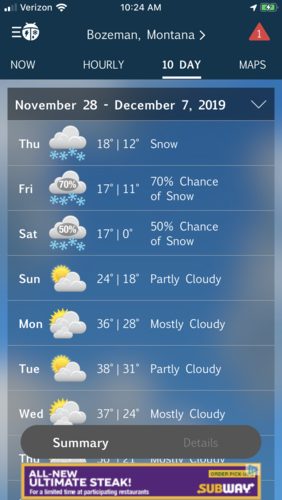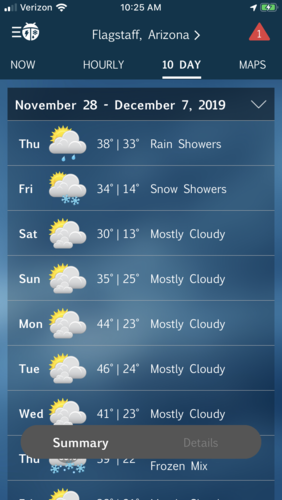BrentD
Well-known member
I would love to see someone hook a chain to those gates and rip them out of the ground.
I would love to see that person then arrested, jailed, fined, and banned from USFS land for a lifetime (or two).
Follow along with the video below to see how to install our site as a web app on your home screen.
Note: This feature may not be available in some browsers.
I would love to see someone hook a chain to those gates and rip them out of the ground.
It sure seems like a strange slippery slope.
Numerous accidents with road blockages all across the county I live in yesterday. Paid first responders as well as volunteers were out on the sides of the interstate doing dangerous work all day long. Our VFD got paged out to a rollover with ejection. All of Montana was busy.
Far more action and danger than anything that’s gonna happen on a USFS road. But the roads were and are open.
Not apples to apples I know, and highways are sometimes closed, but I dislike the spirit of the decision. Mountain roads when closed, should be closed for management decisions and wildlife under official travel plans, not weather. Then again, I suppose weather shuts down roads in other ways like floods or gumbo. It just seems wrong to close the road down due to snow.
I agree. Your point is valid and borne out by an increasing public safety issue here in SW Montana. Gallatin County Search and Rescue (SAR), as well as other public safety groups, is getting spread too thin during such high risk storms and other periods when unthinking nimrods put themselves in danger. Never does the public safety group say, "We aren't going to save that person because they exercised poor judgement." They just gear up and go to help, often putting themselves at risk.The wasn’t there during the conversations, but I’ll wager the decision was made in conjuring the local search and rescue and sheriffs office. I doubt it was an easy decision, and someone intent on logical consistency is probably going to be disappointed.
Why are the roads that access your parking spot to your hunting areas open?I agree. Your point is valid and borne out by an increasing public safety issue here in SW Montana. Gallatin County Search and Rescue (SAR), as well as other public safety groups, is getting spread too thin during such high risk storms and other periods when unthinking nimrods put themselves in danger. Never does the public safety group say, "We aren't going to save that person because they exercised poor judgement." They just gear up and go to help, often putting themselves at risk.
A recent accident involving broken bones of an outfitter hunter resulted in a medical helicopter dispatched but unable to assist due to weather and terrain challenges, then a Malmstrom AFB rescue Huey helicopter made a failed attempt, and finally the rescue helicopter with a hoist, out of the Flathead area completed conflicting rescue missions there and flew down to extract the injured hunter. Afterward, the county sheriff was concerned because the injured hunter's life was not at risk and he could have easily been extracted with ground support. The discussion has evolved into the realization that air extraction (helicopter) medical and rescue support is overtasked at such times and eventually someone whose life is at risk is going to suffer because some nimrod with lesser injuries gets the aviation support. That issue and real dilemma is evident with regard to all the SAR support systems, whether they be ground, water, aviation, winter, summer, or whatever.
So to those anti-gubment, armchair critics of public safety decisions such as closing risky roads during extremely dangerous brief periods of time, I say, "Think about it, become better aware of the challenges faced by SAR and sheriffs' departments, and just get over it!"

But the ones that access these ones aren’t?I agree. Your point is valid and borne out by an increasing public safety issue here in SW Montana. Gallatin County Search and Rescue (SAR), as well as other public safety groups, is getting spread too thin during such high risk storms and other periods when unthinking nimrods put themselves in danger. Never does the public safety group say, "We aren't going to save that person because they exercised poor judgement." They just gear up and go to help, often putting themselves at risk.
A recent accident involving broken bones of an outfitter hunter resulted in a medical helicopter dispatched but unable to assist due to weather and terrain challenges, then a Malmstrom AFB rescue Huey helicopter made a failed attempt, and finally the rescue helicopter with a hoist, out of the Flathead area completed conflicting rescue missions there and flew down to extract the injured hunter. Afterward, the county sheriff was concerned because the injured hunter's life was not at risk and he could have easily been extracted with ground support. The discussion has evolved into the realization that air extraction (helicopter) medical and rescue support is overtasked at such times and eventually someone whose life is at risk is going to suffer because some nimrod with lesser injuries gets the aviation support. That issue and real dilemma is evident with regard to all the SAR support systems, whether they be ground, water, aviation, winter, summer, or whatever.
So to those anti-gubment, armchair critics of public safety decisions such as closing risky roads during extremely dangerous brief periods of time, I say, "Think about it, become better aware of the challenges faced by SAR and sheriffs' departments, and just get over it!"

So to those anti-gubment, armchair critics of public safety decisions such as closing risky roads during extremely dangerous brief periods of time, I say, "Think about it, become better aware of the challenges faced by SAR and sheriffs' departments, and just get over it!"
I agree. Your point is valid and borne out by an increasing public safety issue here in SW Montana. Gallatin County Search and Rescue (SAR), as well as other public safety groups, is getting spread too thin during such high risk storms and other periods when unthinking nimrods put themselves in danger. Never does the public safety group say, "We aren't going to save that person because they exercised poor judgement." They just gear up and go to help, often putting themselves at risk.
A recent accident involving broken bones of an outfitter hunter resulted in a medical helicopter dispatched but unable to assist due to weather and terrain challenges, then a Malmstrom AFB rescue Huey helicopter made a failed attempt, and finally the rescue helicopter with a hoist, out of the Flathead area completed conflicting rescue missions there and flew down to extract the injured hunter. Afterward, the county sheriff was concerned because the injured hunter's life was not at risk and he could have easily been extracted with ground support. The discussion has evolved into the realization that air extraction (helicopter) medical and rescue support is overtasked at such times and eventually someone whose life is at risk is going to suffer because some nimrod with lesser injuries gets the aviation support. That issue and real dilemma is evident with regard to all the SAR support systems, whether they be ground, water, aviation, winter, summer, or whatever.
So to those anti-gubment, armchair critics of public safety decisions such as closing risky roads during extremely dangerous brief periods of time, I say, "Think about it, become better aware of the challenges faced by SAR and sheriffs' departments, and just get over it!"
You missed my point(s).Why are the roads that access your parking spot to your hunting areas open?
You too missed the point. ... now you're just being silly about real life issues.You make some great arguments for selectively utilizing a risk assessment process and determining if something is warranted. But based on your story and results, they may as well stop all back country hunting in it's entirety due to the possibility that the resources are stretched to thin and something may happen. For that matter, in the same philosophy, close every highway in the united states during Thanksgiving because emergency services are overwhelmed during this time of year.
I guess I'm one of those "anti-gubment, armchair critics"...
You too missed the point. ... now you're just being silly about real life issues.
Harley, you nailed it early on. I'm headed for the kitchen ... something smells good.*No win....
Harley, you nailed it early on. I'm headed for the kitchen ... something smells good.
I agree. Your point is valid and borne out by an increasing public safety issue here in SW Montana. Gallatin County Search and Rescue (SAR), as well as other public safety groups, is getting spread too thin during such high risk storms and other periods when unthinking nimrods put themselves in danger. Never does the public safety group say, "We aren't going to save that person because they exercised poor judgement." They just gear up and go to help, often putting themselves at risk.
A recent accident involving broken bones of an outfitter hunter resulted in a medical helicopter dispatched but unable to assist due to weather and terrain challenges, then a Malmstrom AFB rescue Huey helicopter made a failed attempt, and finally the rescue helicopter with a hoist, out of the Flathead area completed conflicting rescue missions there and flew down to extract the injured hunter. Afterward, the county sheriff was concerned because the injured hunter's life was not at risk and he could have easily been extracted with ground support. The discussion has evolved into the realization that air extraction (helicopter) medical and rescue support is overtasked at such times and eventually someone whose life is at risk is going to suffer because some nimrod with lesser injuries gets the aviation support. That issue and real dilemma is evident with regard to all the SAR support systems, whether they be ground, water, aviation, winter, summer, or whatever.
So to those anti-gubment, armchair critics of public safety decisions such as closing risky roads during extremely dangerous brief periods of time, I say, "Think about it, become better aware of the challenges faced by SAR and sheriffs' departments, and just get over it!"
MAFB has well over 300 hundred rescues to date. They do have a hoist and have used them many times for the mission to succeed.The USAF UH-1 helicopters are not rescue helicopters, I wonder why a MTARNG medivac helicopter, with hoist and flight medic wasn’t called?